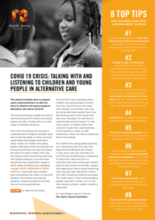Displaying 391 - 400 of 2214
The authors of this study analyzed data from a randomized clinical trial of the middle school version of the Keep Safe intervention - an intervention that targets delinquent peer affiliation - in a sample of girls in foster care. The researchers found that the middle school Keep Safe intervention shows promise as a preventative intervention for reducing affiliation with delinquent peers, which importantly is associated with adolescent delinquent behavior.
This study is a systematic review of the scholarly literature to better understand caregiver-related factors (e.g., characteristics, proficiencies) that contribute to permanency and placement stability, in order to provide a stronger foundation for developing and improving caregiver recruitment and training procedures.
The current study examined the attachment development of 92 internationally adopted Chinese girls, focusing on the influence of type of pre-adoption care (institutional versus foster care) and sensitive adoptive parenting.
This article argues that the current system of care in most jurisdictions forces foster youth to be financially and socially independent at an earlier age, despite insufficient preparation, and notes that healthcare providers can be important advocates for youth in care by championing their medical and psychological needs and serving as a bridge that lasts beyond foster care.
This article explores the important increase in awareness surrounding the care-crime connection (the over-representation of care-experienced individuals in criminal justice settings) in recent years.
This study used content analysis to explore: “What are the post-care housing experiences of youth who have transitioned from care through an independent support program?”
This policy brief reports new causal evidence of how foster care influences children’s safety and educational outcomes in the U.S. state of Michigan.
This briefing explores the importance of self-care for parents and carers, whilst outlining some ‘top-tips’ and helpful resources that can be accessed online.
This study uses a representative sample of foster youth to investigate youth-level and county-level predictors of youths’ roles in their transitional independent living plan (TILP) development and satisfaction with the care decision meetings.
This practice briefing aims to support carers and practitioners to talk and listen to children and young people in alternative care about Covid-19



